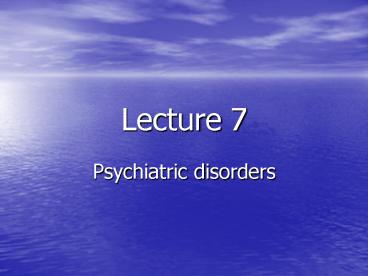Psychiatric disorders - PowerPoint PPT Presentation
1 / 40
Title:
Psychiatric disorders
Description:
Attention Deficit/Hyperactivity Disorder (ADHD) Mega & Cummings, 2001. Mayberg H., 2001 ... Attention Deficit/Hyperactivity Disorder AD/HD diagnostic criteria ... – PowerPoint PPT presentation
Number of Views:796
Avg rating:3.0/5.0
Title: Psychiatric disorders
1
Lecture 7
- Psychiatric disorders
2
Diagnostic difficulties
3
Psychiatric disorders linked to frontal
dysfunction
- Depression and mania
- Schizophrenia
- Obsessive-Compulsive Disorder (OCD)
- Phobias and other anxiety disorders
- Autism-Asperger syndrome
- Attention Deficit/Hyperactivity Disorder (ADHD)
4
(No Transcript)
5
(No Transcript)
6
(No Transcript)
7
(No Transcript)
8
Mega Cummings, 2001
9
Mayberg H., 2001
10
Mayberg H., 2001
11
Maybergs model of depression
Mayberg H., 2001
12
Andreasen N., 2001
13
Hypofrontality in schizophrenia
- First shown by Ingvar and Franzén 1973
- Most pronounced in chronic patients with very
long-lasting hospitalization and treatment with
neuroleptics. Patients display predominantly
negative symptoms. - Unmedicated acutely ill schizophrenic patients
show slightly decreased, normal or even elevated
frontal (resting) blood flow levels dependent
upon the symptoms displayed
positive negative
14
Hypofrontality in schizophrenia cont.
- Functional brain imaging during the execution of
tasks engaging the frontal lobes have
consistently shown abnormalities also in young
unmedicated schizophrenic patients.
15
rCBF differences between 12 controls and 18
schizophrenic patients during performance of an
auditory recognition task
Holcomb et al., Am. J. Psychiatry, 157,
1634-1645, 2000
16
rCBF differences between controls and 6
schizophrenic patients with abnormal performance
on the auditory recognition task
17
Reduced communication between frontal and
temporal lobes during talking in schizophrenia
Ford et al., Biol. Psychiatry, 51, 485-492, 2002
18
Reduced communication between frontal and
temporal lobes during talking in schizophrenia
19
Two trends of cortical development
Archicortical trend
Paleocortical trend
20
Mega Cummings, 2001
21
Obsessive-Compulsive Disorder
- Neuropsychological, brain imaging and
electrophysiological research have consistently
shown a dysfunction of fronto-striato-thalamic
pathways in subjects with obsessive-compulsive
disorder. - Hyperactivity of attention/executive control
mechanisms in obsessive-compulsive patients?
22
Mapping structural brain alterations in
obsessive-compulsive disorder
- Structural MR in 72 outpatients with OCD and 72
age- and sex-matched control subjects. - The brains of patients with OCD showed reduced
gray matter volume in the medial frontal gyrus,
the medial orbitofrontal cortex, and the left
insulo-opercular region. A relative increase in
gray matter volume was observed bilaterally in
the ventral part of the putamen and in the
anterior cerebellum. - Specific parts of the frontostriatal system are
altered in patients with OCD.
Pujol et al., Arch Gen. Psychiatry, 61, 720-730,
2004
23
The Basal Ganglia
Caudate Putamen Nucleusaccumbens
24
(No Transcript)
25
Psychiatric disorders linked to frontal
dysfunction
- Depression and mania
- Schizophrenia
- Obsessive-Compulsive Disorder (OCD)
- Phobias and other anxiety disorders
- Autism-Asperger syndrome
- Attention Deficit/Hyperactivity Disorder (ADHD)
26
Prevalence of autism
- Autism between 0.1-0.3
- Aspergers syndrome 0.20-0.48
- Autism spectrum disturbance 0.1-0.6
- Later studies show that the total prevalence for
autism spectrum disturbances is between 0.5-0.8
27
Cognitive disturbances in Autism spectrum
disorders
- Deficient mentalizing (theory of mind, empathy)
- Deficient central coherence
- Deficient executive functions
- Difficulties with automatization and
generalization
28
10 functional brain imaging studies of mentalizing
Frith, U. Frith C., Phil. Trans. R. Soc. Lond.
B, 358, 459-473, 2003
29
Aspergers syndrome (Gillberg Gillberg 1989)
- 1. Severe difficulties in social interaction.
- 2. Narrow solitary interests.
- 3. Routines and rituals.
- 4. Speech and language problems.
- 5. Problems in non-verbal communication.
- 6. Motor clumsiness.
30
Differences between autism and Aspergers
syndrome?
- Autism more severe language problems, often
lower general intelligence, earlier recognition. - Aspergers syndrome often normal intelligence,
normal language, problems are often realized
later.
31
Brain pathology in autism
- Subnormal frontal activation during execution of
theory of mind tasks. - Cerebellar abnormality (smaller or larger vermis
area). - Less activation of face specific brain areas.
- Deviant visual search in social situations
difficulties recognizing social meaning.
32
Causes of autism spectrum disorders
- Multiple causes Chromosomal abnormalities,
fetal disturbances (infections, toxins). - 75 - 90 of all cases of autism are genetically
determined. Probably several co-operating genes. - Psychosocial factors do not cause autism, but are
important for the quality of life of the patient.
33
Attention Deficit/Hyperactivity Disorder AD/HD
diagnostic criteria
- 6 out of 9 criteria for attention deficit (AD).
- 6 out of 9 criteria for hyperactivity/
impulsivity (HD) fulfilled. - Symptoms present before the age of 7 years.
- Functional disturbances have to be present within
at least to areas (school, home, relations, work).
34
Attentional deficits
- Inattentive
- Seems not to listen
- Does not follow instructions
- Looses objects
- Easily distracted
- Difficulties organizing/planning
- Forgetful
- Dislikes tasks that require mental endurance
- Difficulties with sustained attention to tasks
35
Hyperactivity
- Difficulties to remain on one place
- Speeded
- Excessive talkativeness
- Running around anxiously
- Leaves the place
- Difficulties to perform task in a quite and
orderly way
36
Impulsivity
- Answers before the person asking has finished the
question - Interrupts, intrudes
- Difficulties waiting for ones turn
37
Prevalence of AD/HD
- 3-7 of all school children
- More boys than girls
38
Cognitive problems in AD/HD
- Short attentional span and poor working memory
- Prefers concrete thinking
- Difficulties with automatized functions
- Deficient ability to generalize
- Low level of general knowledge
- Slow learning
- Deficient awareness of time and space
- Difficulties with reading and writing
- Bad handwriting
39
Brain pathology in AD/HD
- Some studies Structural changes in
fronto-striatal networks. - Some studies Subnormal function in the
prefrontal cortex and striatum.
40
Treatment by central stimulants
- Amphetamine, methylphenidate (Ritaline).
- Good or very good effect in about 70 of treated
children (about 200 controlled studies since the
1930-ies). - Adults A few studies, good effect in 50 60.































